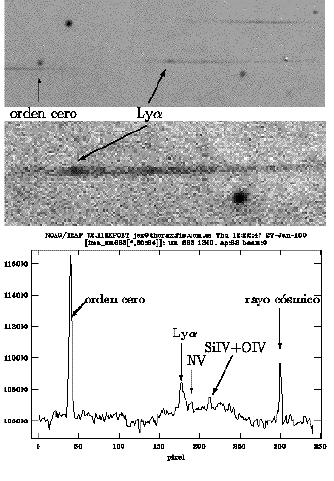CCD slit-less spectroscopy with the Calar Alto 1.23m telescope
F. Prada 1, J. Zamorano 2, W. Müller1, and F. Hoyo1
(1) Centro Astronómico
Hispano-Alemán,
Almería, Spain
(2) Departamento
de Astrofísica, Universidad Complutense de Madrid,
Madrid, Spain
Grating properties
Two plane transmission gratings, manufactured by Bausch & Lomb,
of 150 gr/mm (110 mm x 110 mm) can be used for slit-less spectroscopy
at the 1.23m
telescope
. In the table are listed their properties.
| Grating | | Blaze angle | | Blaze Lambda | | Max. effic. |
| Blue | | 3.05 deg | | 3550 Å | | 78% |
| Red | | 6.30 deg | | 7300 Å | | 78% |
| |
They can be mounted (one each time) on a rotator which is
controlled remotely to set the grating orientation. The
rotator is placed in the f/8 beam of the telescope after
the filter wheel. The distance to the focal plane is around
44 mm, being the final linear reciprocal dispersion of 1500 Å/mm.
For the Site#2b
2048 x 2048 pixel of size 24 microns, the dispersion
is 36 Å/pixel and the field of view 17.2 arcmin square when
using the 100mm diameter filters (Johnson B,V,R,I). The standard
50mm filters also can be used in combination with
the grating but in this the field of view get smaller.
| Observations and first results
Last spring we had the opportunity to commision the
gratings in combination with the 2kx2k CCD camera at the 1.23m
during technical time. In our test observations we
took slit-less spectra of spectrophotometric standard
stars as well as some interesing objects to show the performance
of the gratings.
To illustrate the excellent results obtained
during this run we show in Figure, a zoom image of a QSO
with previously known spectra. This QSO, has a magnitude of
19.1 and a redshift of 3.125. The image and extracted
spectrum shown in the figure correspond to an individual
1200 sec exposure with the Blue grating and no filter with
a seeing of 1.3 arcsec. As
you can clearly see the main
features of the QSO are present, as Lyalpha 1216 Å,
NV 1240 Å, SiIV 1394 Å + OIV 1402 Å.
The emission lines
of the quasar spectrum along with the Balmer series absorption lines of
the standard star HZ4 allowed us to determine the
linear reciprocal dispersion. In the grey-scale image the zero order,
i.e. the direct image without
dispersion, is also present. It corresponds to wavelength null
and can be used in the dispersion determination and as reference to
obtain redshifts. Moreover it can be used to obtain good astrometry
for the objects.
|

|
| Star forming galaxies in the local
universe
C.E. García-Dabó 1, J. Gallego1, J. Zamorano1
(1) Departamento
de Astrofísica, Universidad Complutense de Madrid,
The red grating and a Johnson R filter
are being used by members
of the Departamento
de Astrofísica, de la Universidad Complutense de Madrid
for the search of Halpha emission-line galaxies.
The UCM objective-prism survey was carried out with
the Calar Alto Schmidt telescope using photographic plates.
This is a natural continuation of the
UCM survey
because this instrumental setup, with a CCD as detector,
allows to detect very faint emission-line galaxies.
The UCM team intend to determine the low-end of the
luminosity function of the star forming galaxies of the local universe.
Some promising test images have been taken by F. Prada and the first
run have been carried out recently. Processing of the spectroscopic
images is in progress.
The search for candidates is made with a custom made package called
OPERA . This software
contains a bunch of tools for the automatic analysis of objective-prism
astronomical images. |
A list of references relevant
to our project is given below,
- Alonso
et al. 1994, ApJS 122,415
- Gallego
et al., 1995, ApJL 455, L1
- Gallego
et al. 1997, ApJ 475, 502
- García-Dabó
et al. 1999a, ApSS 263,99
- García-Dabó
et al. 1999b, ApSS 263,95
- Zamorano
et al. 1994, ApJS 95, 387
- Zamorano
et al. 1996, ApJS 105, 343
